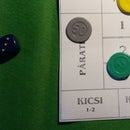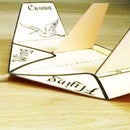Introduction: Sutton-Hoo Lyre or a Saxon Lyre
On the saxon lyre:
The lyre is maybe the ancestor of all the plucked instruments. Egyptians, Greeks, Romans, but, before them the people of the cultures in the iron and copper age used instruments like this. The architecture of it is very simple, but efficient - take a solid frame to hang and hold the strings, attact a soundbox to it, and connect the strings onto it to amplify the sound, when you pluck it. You can play mono- or poliphonic music, chords or glissandos, and more. The saxon lyre is a well known lyre-form, since was found in a burial site in Sutton Hoo, in a grave of its owner, a saxon military man. After them we can know this instrument from the legends of the bards, who became an iconic idols of the lonely, wandering musicians of the age of tales.
Step 1: Tools & Materials
I want to show you how I reconstructed this ancient instrument to play mediaeval music on it. I didn't use any special tools.
Here is the list of the tools you need: Sandpaper, saw (I used a motorized decopir saw to work easy), drill, clamps, cutter, files, and a round-cutter. To draw get a pencil, a liner or perhaps a pair of compasses for the circles and rounds. You should have some glue for wooden parts, and paintbrushes and a varnish ball. The surface ending is optional, I varnished and polished, but the ancestors didn' polished the original ones, as even in the medieval or renaissance instruments were uncovered.
The materials you need: a block of pinewood for the frame and soundbox. Yes, it is enough, never mind this is not hardwood, the architecture is so solid you don't need any harder material for this. But you won't miss the works with hardwood, because you will need a smaller block of it for the tune pegs. This can be beech or oak, or any solid, hardwood. Then get a small block of nice hard- or semi hardwood to carve the string ending - I used mahogany, which is very good for this. And find a short, but strong, 2 mm diameter metal string or wire for the string end support. The varnishing method is your business, but maybe it is useful, more aesthetical and is saves the surface when you grab the instrument during the play. The glue must be a rapid, synthetical liquid one, forget the glue gun, and don't use glue which made of animal bones, and must be hot when used (sorry, I'm not a native speaker, and don't know its proper name, but this glue was the only glue before, very stinky and doesn't resist the air humidity, difficult to work with it, and may cause a lot of confusions. Rather use that white glue for wooden works you can find in any diy shop for cheap).
Step 2: The Plans and the Beginnings
I made some sophisticated drawings, but I wasn't satisfied with them, so made a very puritane blueprint without any pomposity. The frame is a normal frame made of pine, the cover and the back of the soundbox made of 2 mm pure pine board, but not plywood, because the plywood is to hard to transmit the whole sound spectrum to amplify. The thinner pine soundbox cover the better and louder sound - but be careful, don't go under 1,5 mm, because your instrument will be too vulnerable, and the cover may be damaged by the tension of strings. First cut the frame after your plans; the deep of the lyre is about 4-5 cm, the height is about 50-60 cm, and the soundbox begins at the half of it - as you can see on the images. There's no more rules, just imagine and plan it after your imaginations. But don't decrease nor the size of the top part, neither the soundbox - the cca 50-50 percent ratio is the ideal. You can see the thickness of the wall of the soundbox; it's enough to be 2 cm - if much more, the sound may be weaker. But the material must be enough statically to resist the tension; if too small, the lyre may collapse or deform.
Then form the back and the cover board. The correct way is to cut two half parts symmetrically, and glue them to a whole cover (and back). This is for two reasons; first is the visual symmetry, but the other is more important: the filaments in the wood may be inhomogen in the full material, but with this trick we can give an extra homogenity to this very important instrument part, and this make the sound better. When glueing, strenghten the parts with a small cardboard or canvas stripe at the hidden sides of the back and cover as seen.
Step 3: The Next Steps
Well. Now try to cut the center of the cover. Be careful - make a hole at the desired point, and carefully cut a 4 cm diameter disk. DON'T use low speed to avoid the random damages on the edges. Draw around the frame at the soundbox on the back and cover, and cut them. After it you can assemble and glue them. (I carved a rosette into the soundhole, but this was not a tradition at saxon lyres. But if you make one, first glue it on the cover from backward, an assemble the cover onto the frame after it. ) Now the lyre is pretty enough, but the main part is missing. This is the string tune peg block - but, since I have already written the method in a comment, I can easily paste those sentences here:-) See the next title:
Step 4: The Head of the Lyre
How many strings you may use? Originally te saxons used 5-6, but I planned 9 to be able also to non-pentatonic music. The choice is yours,but more then 9 is too much - in my opinion.
Now cut a block from the head of the frame, until the half of the upper part of it. (see the pics). After it cut a corresponding size block from hardwood, to fit it into the empty place you've cut off - glue it, and use clamps to push the parts to each other firmly. This strenghtened part will grab the tuning pegs at the head of the lyre. Here you will drill the holes for tuning pegs, but, please, read carefully the instructions, because this part of the lyre making is very sophisticated, and may contain some traps. I have a good friend, who builds harpsichords, that's why I could get some pegs for harpsichord, but you can use zither pegs, too. First, when you drill the hole for steel pegs (zither or other), remember you should make a hole with lesser diameter than the pegs have. I used pegs with 4 mm, and the hole was 3,8 mm. This proportion (0,9) is very important, otherwise the pegs won't fit strongly, and can't resist the tension of the strings. (I hardly found a drill in the given size, but I didn't give up:-)) Never use other wood than hardwood - the drilling into it will be more problematic, but the pegs must fit safely. Over 6 strings plan the holes in 'W' line, to spare place, and to increase the distance between the holes; the holes with too short distances between one another threaten the block to rip when you insert the peg. And how to insert the pegs into the drilled holes: take a soap (not liquid, but solid), and coat with it the part of the peg you will bury into the hole, before insert it. This is important too, otherwise the pegs will cry when turned. And how to insert? Try it with a rubber hammer, but attach a small hardwood block between the head of the peg and the rubber hammer, and be sure you hold the peg in the proper angle. Be careful, this is the most dangerous part of the building, and that's why you must use the correct size; the larger diameter won't grip as it needed, but, if the hole is too narrow, this is the point, (the hammering) when the hardwood pegblock will rip. Be careful!
The pegs are difficult to get, but you may try to ask a metal turner to make some 4 mm diameter, 3-4 cm long pegs from iron. (No steel needed) You would flatten the top a little bit, and drill the neck with 1-1,5 mm, and curve the butts with a normal hand metal file. Or the turner could use even proper sized bolts (screws) with six side head, removing the screwing surface to be flat (I'm sorry, but I don't know the correct word for this operation:-) ) - and, perhaps this may be more easy...
Step 5: The Bridge and the String Support
I made a trapezoid block, drilled out the inner corners, cut an inner block from it, and carved the frame. You can see this part on the pictures. I used mahogany, because that is a very carveable and interesting reddish-brownish color wood. Never use any woods with larger, inhomogenic filament, unless you want to rip the support when tuning the strings. And you don't need to use harder wood, because the carving will be too hard on it. If you are not sure in the resistance against the tension, don't carve out the inner window, or plan it smaller. Be creative, and try to get a small block of the mahogany, because that won't cause any unwanted surprises... When finished, drill 2 holes at the bottom of the support frame, and insert a 1-1.5 mm diameter brass or copper wire and make a knot to hang it at the butt of lyre; here start the strings running to the tuning pegs. For the proper hanging you should glue a thick stick there - like a leg of a cello. Drill a hole into the butt of the frame, and fit a stick into it with a 1-2 cm outer part - that's all. Then take some hardwood, and carve the bridge. Originally the lyre often made with amber (yes, that yellow mineral which sometimes contains insect fossils). I had not any of this material, but wanted to make a bridge from bone - haven't managed. I was not able to get any legbones of a cow, perhaps, because I live in a capital in Europe, and I unfortunately can see much more cars than cows on the roads:-) But the bone is the ideal. I used a special wood which has some oriental name - I can't recall it:-) It's like the bamboo, but is harder. Works, but I've been chaseing bones for years.
Step 6: Finishing
Polishing, varnishing is not necessary, but recommended. Be creative, you may carve the surface, or may paint, or anything else you can imagine.
And you will need a tuner key or handle. I made mine by a T-shaped screwdriver, fitting a small metal 'grabber' into its nut - sorry again, as a non native speaker I don't the proper name of this small, special thing, but I made it from a nut which was fitting into the larger nut...
Strings and tuning system: I've tried some systems, and strings, and here is my opinion: use plastic, classical guitar strings, and, depending of the free string lenght try to tune them like this: C-D-E-F-G-A-B-c-d. You may tune scordature if needed, for example #F, # C, or bB, bE, e.t.c. depending on the keys or sequences.
I made my lyre at 2008, and I like it very much, I have already on recordings, cd-s, on stages and in the radio, too. Never failed, and the people often ask me about it, because they find it very interesting, exotic instrument. I think, it's easy and worthy of build.
Here is the sound of it:











